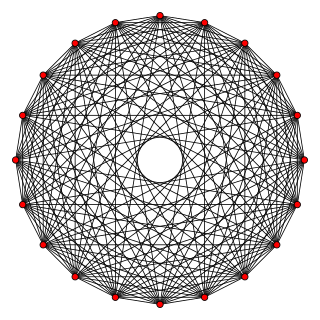Top Qs
Timeline
Chat
Perspective
10-orthoplex
Convex regular polytope in 10 dimensional geometry From Wikipedia, the free encyclopedia
Remove ads
In geometry, a 10-orthoplex or 10-cross polytope, is a regular 10-polytope with 20 vertices, 180 edges, 960 triangle faces, 3360 tetrahedron cells, 8064 5-cell 4-faces, 13440 5-faces, 15360 6-faces, 11520 7-faces, 5120 8-faces, and 1024 9-faces.
It has two constructed forms, the first being regular with Schläfli symbol {38,4}, and the second with alternately labeled (checker-boarded) facets, with Schläfli symbol {37,31,1} or Coxeter symbol 711.
It is one of an infinite family of polytopes, called cross-polytopes or orthoplexes. The dual polytope is the 10-hypercube or 10-cube.
Remove ads
Alternate names
- Decacross is derived from combining the family name cross polytope with deca for ten (dimensions) in Greek. Acronym: ka[1]
- Chilliaicositetraronnon as a 1024-facetted 10-polytope (polyronnon).[2]
Construction
There are two Coxeter groups associated with the 10-orthoplex, one regular, dual of the 10-cube with the C10 or [4,38] symmetry group, and a lower symmetry with two copies of 9-simplex facets, alternating, with the D10 or [37,1,1] symmetry group.
Cartesian coordinates
Cartesian coordinates for the vertices of a 10-orthoplex, centred at the origin are
- (±1,0,0,0,0,0,0,0,0,0), (0,±1,0,0,0,0,0,0,0,0), (0,0,±1,0,0,0,0,0,0,0), (0,0,0,±1,0,0,0,0,0,0), (0,0,0,0,±1,0,0,0,0,0), (0,0,0,0,0,±1,0,0,0,0), (0,0,0,0,0,0,±1,0,0,0), (0,0,0,0,0,0,0,±1,0,0), (0,0,0,0,0,0,0,0,±1,0), (0,0,0,0,0,0,0,0,0,±1)
Every vertex pair is connected by an edge, except opposites.
Images
Notes
References
External links
Wikiwand - on
Seamless Wikipedia browsing. On steroids.
Remove ads










